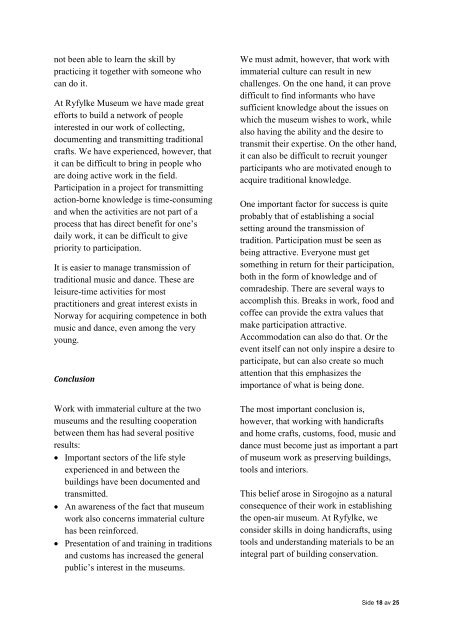Methods in working with intangible cultural heritage - report
Report on a cooperative project between Музејнаотвореном СТАРО СЕЛО (The open-air museum “Old Village”), Sirogojno, Serbia and Ryfylkemuseet (The RyfylkeMuseum), Sand, Norway.
Report on a cooperative project between Музејнаотвореном СТАРО СЕЛО (The open-air museum “Old Village”), Sirogojno, Serbia and Ryfylkemuseet (The RyfylkeMuseum), Sand, Norway.
You also want an ePaper? Increase the reach of your titles
YUMPU automatically turns print PDFs into web optimized ePapers that Google loves.
not been able to learn the skill by<br />
practic<strong>in</strong>g it together <strong>with</strong> someone who<br />
can do it.<br />
At Ryfylke Museum we have made great<br />
efforts to build a network of people<br />
<strong>in</strong>terested <strong>in</strong> our work of collect<strong>in</strong>g,<br />
document<strong>in</strong>g and transmitt<strong>in</strong>g traditional<br />
crafts. We have experienced, however, that<br />
it can be difficult to br<strong>in</strong>g <strong>in</strong> people who<br />
are do<strong>in</strong>g active work <strong>in</strong> the field.<br />
Participation <strong>in</strong> a project for transmitt<strong>in</strong>g<br />
action-borne knowledge is time-consum<strong>in</strong>g<br />
and when the activities are not part of a<br />
process that has direct benefit for one’s<br />
daily work, it can be difficult to give<br />
priority to participation.<br />
It is easier to manage transmission of<br />
traditional music and dance. These are<br />
leisure-time activities for most<br />
practitioners and great <strong>in</strong>terest exists <strong>in</strong><br />
Norway for acquir<strong>in</strong>g competence <strong>in</strong> both<br />
music and dance, even among the very<br />
young.<br />
Conclusion<br />
Work <strong>with</strong> immaterial culture at the two<br />
museums and the result<strong>in</strong>g cooperation<br />
between them has had several positive<br />
results:<br />
Important sectors of the life style<br />
experienced <strong>in</strong> and between the<br />
build<strong>in</strong>gs have been documented and<br />
transmitted.<br />
An awareness of the fact that museum<br />
work also concerns immaterial culture<br />
has been re<strong>in</strong>forced.<br />
Presentation of and tra<strong>in</strong><strong>in</strong>g <strong>in</strong> traditions<br />
and customs has <strong>in</strong>creased the general<br />
public’s <strong>in</strong>terest <strong>in</strong> the museums.<br />
We must admit, however, that work <strong>with</strong><br />
immaterial culture can result <strong>in</strong> new<br />
challenges. On the one hand, it can prove<br />
difficult to f<strong>in</strong>d <strong>in</strong>formants who have<br />
sufficient knowledge about the issues on<br />
which the museum wishes to work, while<br />
also hav<strong>in</strong>g the ability and the desire to<br />
transmit their expertise. On the other hand,<br />
it can also be difficult to recruit younger<br />
participants who are motivated enough to<br />
acquire traditional knowledge.<br />
One important factor for success is quite<br />
probably that of establish<strong>in</strong>g a social<br />
sett<strong>in</strong>g around the transmission of<br />
tradition. Participation must be seen as<br />
be<strong>in</strong>g attractive. Everyone must get<br />
someth<strong>in</strong>g <strong>in</strong> return for their participation,<br />
both <strong>in</strong> the form of knowledge and of<br />
comradeship. There are several ways to<br />
accomplish this. Breaks <strong>in</strong> work, food and<br />
coffee can provide the extra values that<br />
make participation attractive.<br />
Accommodation can also do that. Or the<br />
event itself can not only <strong>in</strong>spire a desire to<br />
participate, but can also create so much<br />
attention that this emphasizes the<br />
importance of what is be<strong>in</strong>g done.<br />
The most important conclusion is,<br />
however, that work<strong>in</strong>g <strong>with</strong> handicrafts<br />
and home crafts, customs, food, music and<br />
dance must become just as important a part<br />
of museum work as preserv<strong>in</strong>g build<strong>in</strong>gs,<br />
tools and <strong>in</strong>teriors.<br />
This belief arose <strong>in</strong> Sirogojno as a natural<br />
consequence of their work <strong>in</strong> establish<strong>in</strong>g<br />
the open-air museum. At Ryfylke, we<br />
consider skills <strong>in</strong> do<strong>in</strong>g handicrafts, us<strong>in</strong>g<br />
tools and understand<strong>in</strong>g materials to be an<br />
<strong>in</strong>tegral part of build<strong>in</strong>g conservation.<br />
Side 18 av 25




